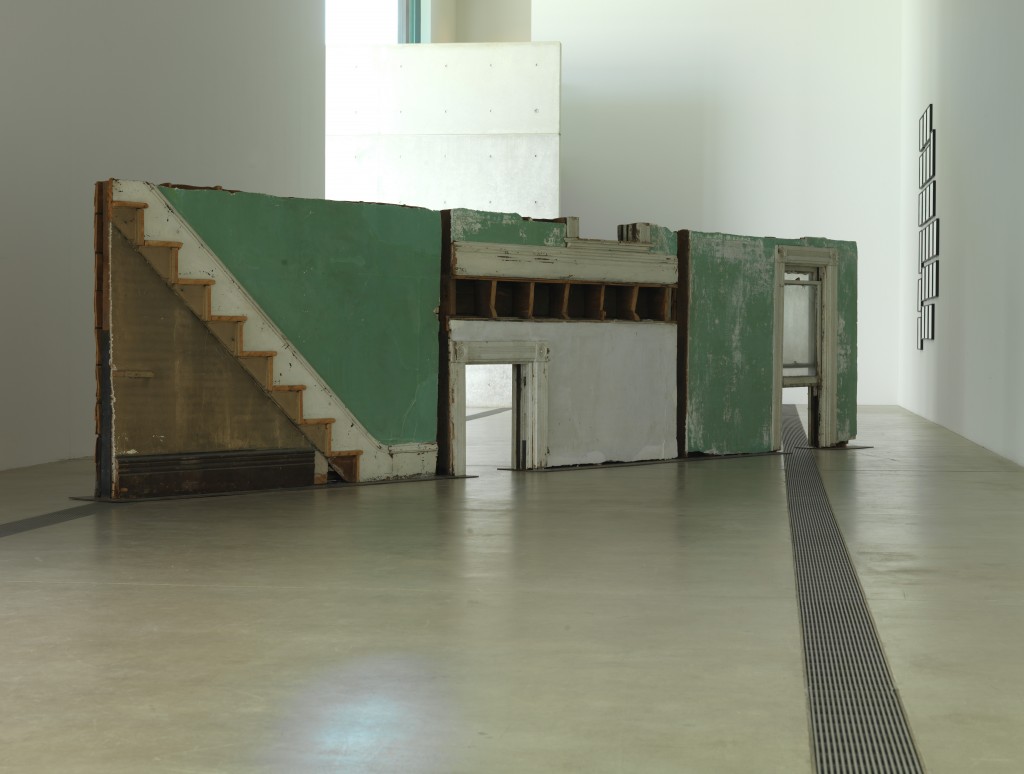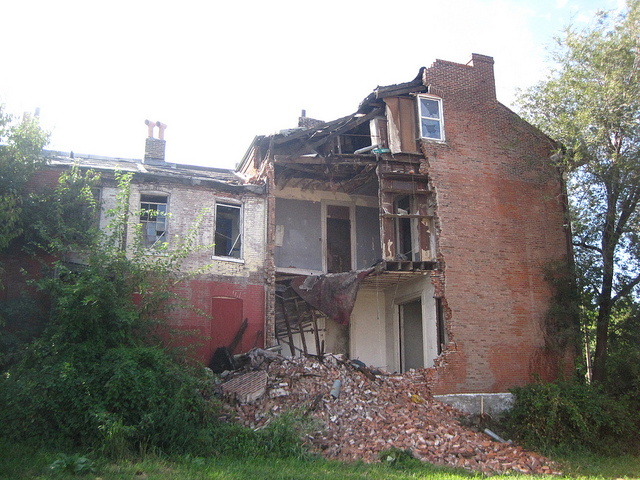For years, whenever I have dreamed of St. Louis, I have conjured images of buildings half-standing, half-open to the world. Invariably, the back wall of the house is missing, and I can peer right inside to the remainder of the house. There’s a mix of danger and excitement in these dreams: danger for I know that a neighborhood with disintegrating buildings is not safe for a white woman exploring on her own, excitement because I can see into the houses, see the lives people are leading in them. For make no mistake: though they are missing back walls, these houses are still occupied. To look at them from the front, you’d have no idea they’re crumbling.
Imagine the shock of recognition I felt when I first stumbled across Robert Powers’s striking photos of disintegrating St. Louis buildings. Check out some of them here, here, here, here, and here. Over at the Preservation Research Office, Michael R. Allen also has some powerful photos of buildings that have been hit by brisk rustlers (watch for a future post on this phenomenon). Check out Allen’s photos here and here.
Then imagine my true delight when I came across the work of Gordon Matta-Clark (1943-1978). According to Wikipedia, “He is famous for his ‘building cuts,’ a series of works in abandoned buildings in which he variously removed sections of floors, ceilings, and walls.” Matta-Clark described his process this way:
I made a series of visits to the ghetto areas of the Lower East Side and the Bronx visiting buildings occupied primarily by packs of dogs and periodically by junkies. Many of the buildings had suffered heavy arson and were the epitomy [sic] of urban neglect. These first works simply involved moving into spaces with a handsaw and cutting away rectangular sections of the floor or walls to create a view from one space into another. The sections were carefully removed from their original positions to an art gallery. The working conditions were always the most adverse I can remember. We were not only stopped by the police on several occasions but also by roving gangs from the neighbor-hood [sic]. There was always an acute sense of paranoia that accompanied this work.

Gordon Matta-Clark, Bingo, 1974; The Museum of Modern Art, New York; Nina and Gordon Bunshaft Bequest Fund, Nelson A. Rockefeller Bequest Fund, and the Enid A. Haupt Fund, 2004. Installation photography © Francois Robert Gordon Matta-Clark works © Estate of Gordon Matta-Clark / Artist Rights Society (ARS), New York
Recently, Matta-Clark’s art was on exhibit at St. Louis’s Pulitzer Foundation for the Arts. Titled Urban Alchemy, the exhibit featured installations (such as “Bingo” and “Bronx Floors: Double Doors”) as well as photographs of his “interventions” (such as “Splitting” and “Untitled [Anarchitecture]”). The Urban Alchemy exhibit catalog (available for purchase) describes Matta-Clark’s work this way:
Gordon Matta-Clark used neglected structures slated for demolition as his raw material. He carved out sections of buildings in order to reveal their hidden constructions, to provide new ways of perceiving space, and to create metaphors for the human condition. When wrecking balls knocked down his sculpted buildings, little remained. He took photographs and films of his interventions and kept a few of the building segments.
Although Matta-Clark did not construct any of his art in St. Louis (most of his pieces focus on buildings in and around his hometown of New York), the pieces on display at the Pulitzer nevertheless resonate with the St. Louis urban landscape. As the Urban Alchemy curators note, the Pulitzer exhibit “builds upon Matta-Clark’s desire to give abandoned objects and buildings new meaning by connecting the artist’s social activism to present-day St. Louis.” In fact, the Pulitzer hosted a series of “transformative” events in conjunction with the exhibit, events designed to “reactivate Matta-Clark’s legacy of socially-engaged art drawn from the urban environment and the people who bring life to the community” – and to do so in a way that would be relevant and particular to St. Louis. “By engaging the community in acts of individual and collective transformation of all types,” says the Matta-Clark Transformation website, “the Pulitzer hopes to help carry Matta-Clark’s legacy into the 21st century and inspire a new generation of social activism through creative acts.” At the website, you’ll find videos of St. Louisans reflecting on neighborhood, highlights of St. Louis’s version of Matta-Clark’s famous “Garbage Wall” installation, and excerpts from a panel discussion of leading St. Louis thinkers.
The Urban Alchemy exhibit catalog is chock full of statements from Matta-Clark as to what he was up to in creating his “anarchitecture.” “As an artist I make sculpture using the natural by-products of the land and people,” he said in 1970. “I am interested in turning wasted areas such as blocks of rubble, empty lots, dumps into beautiful and useful areas.” And in 1975, he described his artistic efforts this way:
Work with abandoned structures began with my concern for the life of the city of which a major side effect is the metabolization of old buildings. Here as in many urban centers the availability of empty and neglected structures was a prime textural reminder of the ongoing fallacy of renewal through modernization. The omnipresence of emptiness, of abandoned housing and imminent demolition gave me the freedom to experiment with the multiple alternatives to one’s life in a box as well as popular attitudes about the need for enclosure.
Matta-Clark’s widow, Jane Crawford, says that, as a self-described urban archaeologist, Matta-Clark “saw what he was doing as transformative, using what no one else wanted.” In the 1970s, she says, “New York City had many derelict buildings and neighborhoods. Gordon would move into a space and transform it the way an alchemist might. . . . [H]e liked the idea of taking the sow’s ear and spinning gold out of it.”
You can learn more about Matta-Clark’s work by reading this New York Times article, this artnet feature, and this ARTINFO.com article on a 2007 Matta-Clark exhibit at the Whitney. See also Stefene Russell’s St. Louis Magazine article, “Cameo: Space Man,” as well as St. Louis blogger Michael R. Allen’s thoughts on the Pulitzer show. “Out of his brutal dissection,” writes Allen, “emerged works that raise more questions about the contemporary urban condition than can ever be answered.” Allen draws particular parallels to the devastation the St. Louis urban landscape is currently facing.
To view Matta-Clark’s work, visit the Urban Alchemy website. If you Google “Gordon Matta-Clark” and click “Images,” you’ll find a treasure trove of his pieces. You might also want to check out his video, “Conical Intersect,” which details the cuts he made on two Paris buildings.
“When you’re living in a city,” Matta-Clark said in a 1974 interview, “the whole fabric is architectural in some sense. We were thinking more about metaphoric voids, gaps, left-over spaces, places that were not developed.”
Voids, gaps, left-over spaces . . . the St. Louis images that haunt me in my dreams.
Tags: Anarchitecture, Architecture, Decaying Building, Gordon Matta-Clark, Houses, Michael Allen, Pulitzer Foundation for the Arts, St. Louis, Urban Blight
